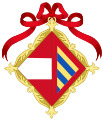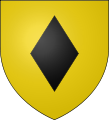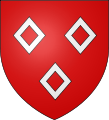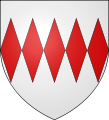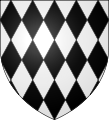- Lozenge (heraldry)
-
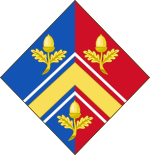 Pippa Middleton's coat of arms, based on those of her father. This lozenge shaped version, supported by a blue ribbon, denotes a spinster and can be used by no one else.[1][2]
Pippa Middleton's coat of arms, based on those of her father. This lozenge shaped version, supported by a blue ribbon, denotes a spinster and can be used by no one else.[1][2]
The lozenge in heraldry is a diamond-shaped charge (an object that can be placed on the field of the shield), usually somewhat narrower than it is tall. It is to be distinguished in modern heraldry from the fusil, which is like the lozenge but narrower, though the distinction has not always been as fine and is not always observed even today. A mascle is a voided lozenge—that is, a lozenge with a lozenge-shaped hole in the middle—and the rarer rustre is a lozenge containing a circular hole in the centre. A field covered in a pattern of lozenges is described as lozengy; similar fields of mascles are masculy, and fusils, fusily.
The lozenge has for many centuries been particularly associated with women as a vehicle for the display of their coats of arms (instead of the escutcheon or shield). In modern English and Scottish, but not Canadian, heraldry, the arms of an unmarried woman and of widows are usually shown on a lozenge rather than an escutcheon, without crest or helm. An oval or cartouche is occasionally also used instead of the lozenge for such women.
Married women, however, always display their arms on a shield (except peeresses in their own right, who use the lozenge for their peerage arms even during marriage).
The shield of a married woman (and the lozenge of a widow) may combine her own arms with the arms of her husband, either by impalement side by side or (in the case of an heraldic heiress in English heraldry, but not Scots) in the form of a small "escutcheon of pretence" displaying the wife's arms over a larger shield (or, in the case of a widow, lozenge) of her husband's arms.
As a result of rulings of the English Kings of Arms dated 7 April 1995 and 6 November 1997, married women in England, Northern Ireland and Wales and in other countries recognising the jurisdiction of the College of Arms in London (such as New Zealand) also have the option of using their husband's arms alone, marked with a small lozenge as a brisure to show that the arms are displayed for the wife and not the husband, or of using their own personal arms alone, marked with a small shield as a brisure for the same reason.
Divorced women may theoretically until remarriage use their ex-husband's arms differenced with a mascle.
The lozenge shape is also used for funereal hatchments for both men and women.
Schools
Pretoria High School for Girls in South Africa is one of the few all-girls schools that was granted permission to use the lozenge as part of its coat of arms.
-
This Monegasque flag is "lozengy argent and gules"
-
The personal arms of Margaret of Parma
-
Funereal hatchment of Elizabeth Bowes-Lyon, on the traditional lozenge-shaped board
This file is a candidate for speedy deletion. It may be deleted after Saturday, 26 November 2011. -
The personal coat of arms of Anne, Princess Royal displayed on a lozenge.
-
The personal coat of arms of Elena of Spain, Duchess of Lugo displayed on a lozenge.
-
The arms of Catherine, Duchess of Cambridge, prior to her marriage to H.R.H. Prince William, Duke of Cambridge, displayed on a lozenge
Further reading
- Fox-Davies, Arthur Charles (1909). A Complete Guide to Heraldry. New York: Dodge Pub. Co.(and ther more recent editions) LCCN 09-023803
- Canadian Heraldic Authority, Public Register, with many useful official versions of modern coats of arms, searchable online archive.gg.ca
- South African Bureau of Heraldry, data on registered heraldic representations (part of National Archives of South Africa); searchable online (but sadly no illustration), national.archsrch.gov.za
- Civic Heraldry of England and Wales, fully searchable with illustrations, civicheraldry.co.uk
- Heraldry Society of Scotland, members' arms, fully searchable with illustrations of bearings, heraldry-scotland.com
- Heraldry Society (England), members' arms, with illustrations of bearings, only accessible by armiger's name (though a Google site search would provide full searchability), theheraldrysociety.com
- Royal Heraldry Society of Canada, Members' Roll of Arms , with illustrations of bearings, only accessible by armiger's name (though a Google site search would provide full searchability), heralrdry.ca
- Brooke-Little, J P , Norroy and Ulster King of Arms, An heraldic alphabet (new and revisded edition), Robson Books, London, 1985 (first edition 1975); sadly very few illustrations
- Greaves, Kevin, A Canadian Heraldic Primer, Heraldry Society of Canada, Ottawa, 2000, lots but not enough illustrations
- Moncreiffe of Easter Moncreiffe, Iain, Kintyre Pursuivant of Arms, and Pottinger, Don , Herald Painter Extraordinary to the Court of the Lord Lyon King of Arms Simple Heraldry, Thomas Nelson and Sons, London andf Edinburgh, 1953; splendidly illustrated
- Friar, Stephen (ed) A New Dictionary of Heraldry Alphabooks, Sherborne, 1987; sadly with very few illustration of attitudes
References
- ^ "Royal wedding: Kate Middleton coat of arms unveiled". BBC News. 19 April 2011. http://www.bbc.co.uk/news/uk-13127145. Retrieved 19 April 2011.
- ^ Bates, Stephen (19 April 2011). "Kate Middleton family gets coat of arms". The Guardian (UK). http://www.guardian.co.uk/uk/2011/apr/19/kate-middleton-coat-of-arms. Retrieved 19 April 2011.
Categories:- Heraldry
- Heraldic charges
-
Wikimedia Foundation. 2010.



